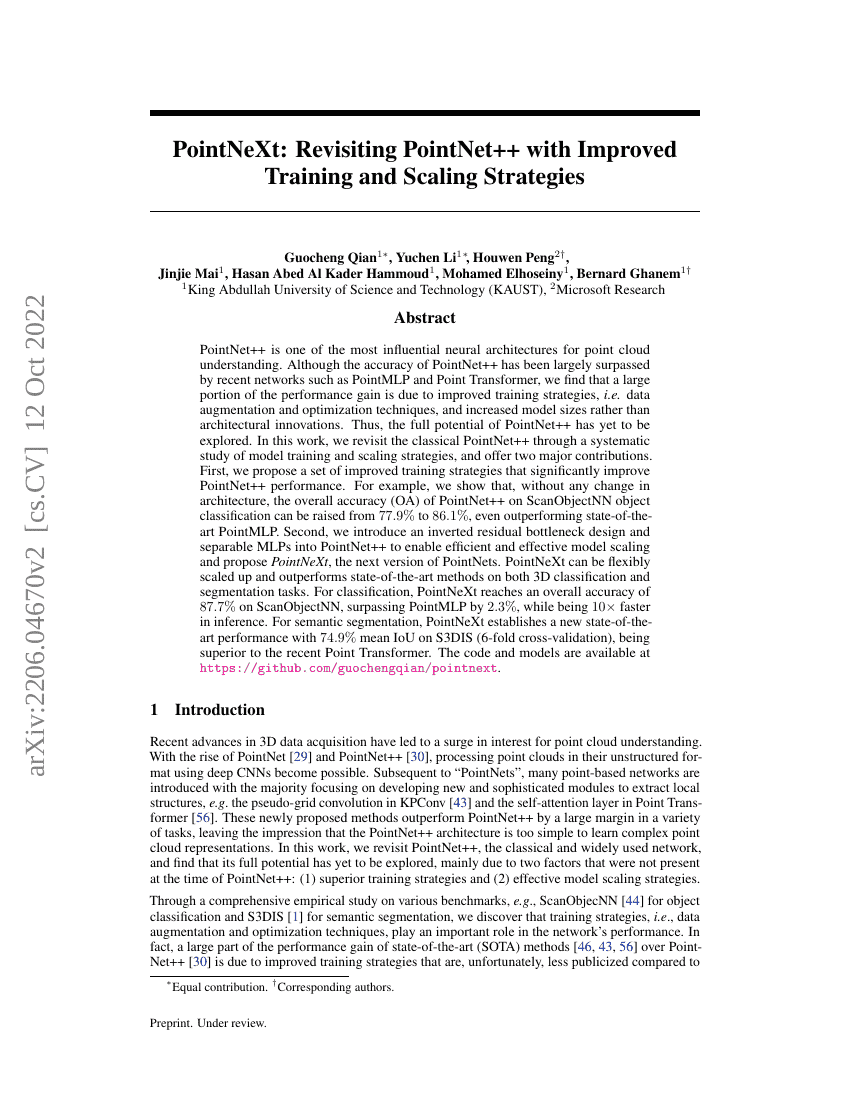Command Palette
Search for a command to run...
PointNeXt: Revisiting PointNet++ with Improved Training and Scaling Strategies
Qian Guocheng ; Li Yuchen ; Peng Houwen ; Mai Jinjie ; Hammoud Hasan Abed Al Kader ; Elhoseiny Mohamed ; Ghanem Bernard

Abstract
PointNet++ is one of the most influential neural architectures for pointcloud understanding. Although the accuracy of PointNet++ has been largelysurpassed by recent networks such as PointMLP and Point Transformer, we findthat a large portion of the performance gain is due to improved trainingstrategies, i.e. data augmentation and optimization techniques, and increasedmodel sizes rather than architectural innovations. Thus, the full potential ofPointNet++ has yet to be explored. In this work, we revisit the classicalPointNet++ through a systematic study of model training and scaling strategies,and offer two major contributions. First, we propose a set of improved trainingstrategies that significantly improve PointNet++ performance. For example, weshow that, without any change in architecture, the overall accuracy (OA) ofPointNet++ on ScanObjectNN object classification can be raised from 77.9% to86.1%, even outperforming state-of-the-art PointMLP. Second, we introduce aninverted residual bottleneck design and separable MLPs into PointNet++ toenable efficient and effective model scaling and propose PointNeXt, the nextversion of PointNets. PointNeXt can be flexibly scaled up and outperformsstate-of-the-art methods on both 3D classification and segmentation tasks. Forclassification, PointNeXt reaches an overall accuracy of 87.7 on ScanObjectNN,surpassing PointMLP by 2.3%, while being 10x faster in inference. For semanticsegmentation, PointNeXt establishes a new state-of-the-art performance with74.9% mean IoU on S3DIS (6-fold cross-validation), being superior to the recentPoint Transformer. The code and models are available athttps://github.com/guochengqian/pointnext.
Code Repositories
Benchmarks
| Benchmark | Methodology | Metrics |
|---|---|---|
| 3d-part-segmentation-on-shapenet-part | PointNeXt | Class Average IoU: 85.2 Instance Average IoU: 87.1 |
| 3d-point-cloud-classification-on-modelnet40 | PointNeXt | FLOPs: 6.5G Mean Accuracy: 91.1 Number of params: 4.5M Overall Accuracy: 94.0 |
| 3d-point-cloud-classification-on-scanobjectnn | PointNeXt | FLOPs: 1.64G Mean Accuracy: 86.8 Number of params: 1.4M Overall Accuracy: 88.2 |
| 3d-semantic-segmentation-on-opentrench3d | PointNeXt-XL | Model Size: 41.5M mAcc: 79.7 mIoU: 70.6 |
| 3d-semantic-segmentation-on-s3dis | PointNext | mIoU (6-Fold): 74.9 mIoU (Area-5): 70.5 |
| semantic-segmentation-on-s3dis | PointNeXt-XL | FLOPs: 84.8G Mean IoU: 74.9 Number of params: 41.6M Params (M): 41.6 mAcc: 83.0 oAcc: 90.3 |
| semantic-segmentation-on-s3dis | PointNeXt-L | FLOPs: 15.2G Mean IoU: 73.9 Number of params: 7.1M Params (M): 7.1 mAcc: 82.2 oAcc: 89.9 |
| semantic-segmentation-on-s3dis-area5 | PointNeXt | Number of params: 41.6M mAcc: 77.2 mIoU: 71.1 oAcc: 91.0 |
| supervised-only-3d-point-cloud-classification | PointNeXt | GFLOPs: 3.6 Number of params (M): 1.4 Overall Accuracy (PB_T50_RS): 87.8 |
Build AI with AI
From idea to launch — accelerate your AI development with free AI co-coding, out-of-the-box environment and best price of GPUs.